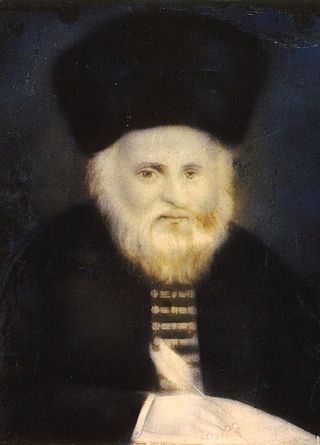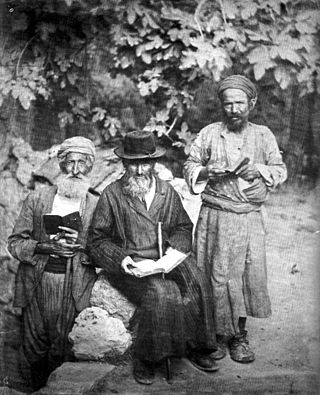Related Research Articles

Saʿadiah ben Yosef Gaon was a prominent rabbi, gaon, Jewish philosopher, and exegete who was active in the Abbasid Caliphate.

The exilarch was the leader of the Jewish community in Persian Mesopotamia during the era of the Parthians, Sasanians and Abbasid Caliphate up until the Mongol invasion of Baghdad in 1258 CE, with intermittent gaps due to ongoing political developments. The exilarch was regarded by the Jewish community as the royal heir of the House of David and held a place of prominence as both a rabbinical authority and as a noble within the Persian court. Within the Sasanian Empire, the exilarch was the political equivalent of the Catholicos of the Christian Church of the East, and was thus responsible for community-specific organizational tasks such as running the rabbinical courts, collecting taxes from Jewish communities, supervising and providing financing for the Talmudic academies in Babylonia, and the charitable re-distribution and financial assistance to needy members of the exile community. The position of exilarch was hereditary, held in continuity by a family that traced its patrilineal descent from antiquity stemming from king David.

Elijah ben Solomon Zalman, known as the Vilna Gaon or Elijah of Vilna, or by his Hebrew acronym Gra, was a Lithuanian Jewish Talmudist, halakhist, kabbalist, and the foremost leader of misnagdic (non-hasidic) Jewry of the past few centuries. He is commonly referred to in Hebrew as ha-Gaon he-Chasid mi-Vilna, "the pious genius from Vilnius".

Amram Gaon was a gaon, head of the Jewish Talmud Academy of Sura during the 9th century.

The Davidic line or House of David refers to the lineage of the Israelite king David. In Judaism it is based on texts from the Hebrew Bible and through the succeeding centuries based on later traditions. In Christianity, the New Testament follows the line through Mary and Joseph to Jesus.
Geonim were the presidents of the two great Babylonian Talmudic Academies of Sura and Pumbedita, in the Abbasid Caliphate, and were the generally accepted spiritual leaders of the Jewish community worldwide in the early medieval era, in contrast to the Resh Galuta (exilarch) who wielded secular authority over the Jews in Islamic lands.
Sherira bar Hanina more commonly known as Sherira Gaon was the gaon of the Academy of Pumbeditha. He was one of the most prominent Geonim of his period, and the father of Hai Gaon, who succeeded him as Gaon. He wrote the Iggeret Rav Sherira Gaon, a comprehensive history of the composition of the Talmud.
Nissim ben Jacob, was a rabbi best known today for his Talmudic commentary ha-Mafteach, by which title he is also known.
Jehoshaphat ben Josiah was the son of Josiah ben Saul, the great-grandson of Anan ben David, a Nasi, and a Rosh Yeshivah, during the early ninth century. He lived in Israel where he was head of the Palestinian Yeshiva. Jehoshaphat was nasi and resh galuta of the nascent Karaite movement of Judaism, though it is likely that he was a Rabbanite himself due to his affiliation with the Palestinian Yeshiva. He was the father of Boaz ben Jehoshaphat. His brother Semah was head of the Palestinian Gaonate after him.

Yisroel ben Shmuel Ashkenazi of Shklov was a Lithuanian Jewish Talmudist, one of a group of Talmudical scholars of Shklov who were attracted to Vilna by Rabbi Elijah ben Solomon Zalman, known as the Vilna Gaon (1720–97). He was one of "the last arrivals," and attended upon the Gaon as a disciple for less than a year.
Aaron ben Meïr was a rabbi and a Nasi of the Palestinian Gaonate in the first half of the tenth century. His name was brought to light by several fragments discovered in various genizoth. The fragments contain an account of a controversy between Ben Meïr and the Talmudic Academies in Babylonia regarding the Hebrew calendar.
Aaron ibn Sargado or Aaron ben R. Joseph ha-Kohen was a tenth-century AD gaon in Pumbedita, Babylonia. He was a son of Joseph ha-Kohen.
The Land of Israel Gaonate was the chief talmudical academy and central legalistic body of the Jewish community in Palestine during the middle of the ninth century, or even earlier, till its demise during the 11th-century. During its existence, it competed with the Babylonian Gaonate for the support of the growing diasporic communities. The Egyptian and German Jews particularly regarded the Palestinian geonim as their spiritual leaders. The history of the gaonate was revealed in documents discovered in the Cairo genizah in 1896. Sparse information is available on the Palestinian geonim prior to the middle of the ninth century. The extant material consists essentially of a list in Seder Olam Zuta relating all the geonim to Mar Zutra.
Palestinian rabbis encompasses all rabbis who lived in the region known as Palestine up until modern times, but most significantly refers to the early Jewish sages who dwelled in the ancient Holy Land and compiled the Mishna and its later commentary, the Jerusalem Talmud. These rabbis lived between 150 BCE and 400 CE and during the Talmudic and later Geonic period, they exerted influence over Syria and Egypt, while the authorities in Babylonia had held sway over the Jews of Iraq and Iran. While the Jerusalem Talmud was not to become authoritative against the Babylonian, the liturgy developed by Palestinian rabbis was later destined to form the foundation of the minhag of nearly all the Ashkenazic communities across Europe.
The Tunisian city of Kairouan, also known as Kirwan or al-Qayrawan was a world center of Talmudic and Halakhic scholarship for at least three generations.
Semah ben Josiah was the great-grandson of Anan ben David, a Nasi, and the head of the Palestinian yeshiva in the 9th century.
Abraham ben Aaron was a head of the Palestinian Gaonate in the 10th century.
Aaron ha-Cohen was a head of the Palestinian Gaonate in the 10th century.
References
- 1 2 3 Encyclopaedia Judaica, 1972. Vol. 5, pg. 1291.
- ↑ Gil, Moshe (1992), A history of Palestine, 634-1099, translated by Broido, Ethel, Cambridge: Cambridge University Press, p. Section 858, ISBN 9780521599849
- ↑ Jewish Encyclopedia: Gaon